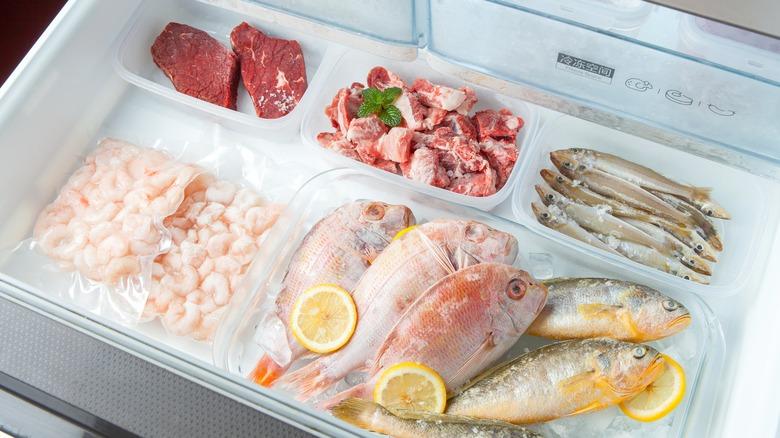Frozen Food: A Smart and Easy Choice for Every Home

In our busy lives, cooking a fresh meal every day is not always possible. We all want to eat healthy and tasty food, but sometimes we don’t have the time or energy to shop, wash, cut, and cook everything from scratch. This is where frozen food becomes a great solution. It is easy to store, quick to prepare, and often very affordable. In this blog, we will explain what frozen food is, how it helps, clear up common misunderstandings, and give tips on using it in your daily life — all in simple, easy-to-read English.
What Is Frozen Food?
Frozen food is any type of food that has been kept at a very low temperature so it stays fresh for a long time. Freezing slows down the growth of bacteria and keeps food safe to eat. Almost any food can be frozen, including fruits, vegetables, meats, seafood, ready meals, breads, snacks, and desserts.
Freezing doesn’t mean food becomes unhealthy. In fact, many frozen foods are frozen at their freshest point, which helps keep their nutrients and flavor locked in.
Why Frozen Food Is a Good Choice
Let’s look at the many benefits of frozen food:
Saves Time
One of the biggest reasons people use frozen food is because it saves time. You don’t have to spend hours shopping, peeling, chopping, or cooking. You can simply take something out of the freezer, heat it, and enjoy your meal in just a few minutes. This is very helpful for people who work long hours, parents with young children, students, or anyone who wants a quick meal.
Reduces Food Waste
Many of us buy fresh fruits and vegetables with good intentions but end up throwing them away when they go bad. With frozen food, you don’t have to worry about this. You can store it for months, and only use what you need. This helps you reduce waste and save money.
Keeps Food Fresh Longer
Freezing helps keep food fresh. Frozen fruits and vegetables are often frozen right after they are picked, which helps keep the vitamins and minerals inside. Unlike some fresh produce that may sit in stores for days, frozen food can sometimes be fresher and more nutritious.
Affordable and Budget-Friendly
Frozen food is often cheaper than fresh food. For example, fresh berries may be expensive during certain months, but frozen berries are available all year round and at a lower price. You can also buy frozen food in large packs, which saves you money in the long run.
Available All Year Round
Some fruits and vegetables are seasonal, which means they are only available at certain times of the year. Frozen food allows you to enjoy these foods whenever you want. You can eat your favorite fruits like mango or berries even in winter.
Convenient and Easy to Use
Frozen food is very easy to prepare. You don’t need to do any washing, peeling, or chopping. It’s ready to use in your recipes or to heat and eat. This is perfect for busy mornings, late-night snacks, or last-minute dinners.
Types of Frozen Food
There are many types of frozen food available today. Some of the most common ones include:
-
Frozen vegetables and fruits: Peas, corn, spinach, mango, berries, etc.
-
Frozen meat and seafood: Chicken breasts, fish fillets, prawns, etc.
-
Ready-to-eat meals: Pizzas, pasta, curries, rice bowls, and more.
-
Frozen snacks and appetizers: Nuggets, fries, spring rolls, samosas.
-
Frozen desserts: Ice cream, frozen yogurt, frozen cakes and pies.
These foods come in neat packaging, often with cooking instructions, which makes them even easier to use.
Common Myths About Frozen Food
Let’s clear up some common misunderstandings:
Frozen food is not healthy.
Many frozen foods are full of nutrients. In fact, frozen vegetables are often frozen right after harvesting, which keeps the vitamins inside.
Frozen food is full of chemicals.
Freezing is a natural way to preserve food. Many frozen products do not need any added preservatives.
Frozen food doesn’t taste good.
Today’s freezing methods keep flavors fresh. Many frozen meals and snacks taste just as good as freshly cooked ones.
How to Use Frozen Food the Right Way
Here are some tips to get the most out of your frozen food:
-
Read the labels: Choose options with simple ingredients. Try to avoid too much salt, sugar, or additives.
-
Don’t refreeze after thawing: Once you defrost frozen food, use it. Refreezing can lower the quality and taste.
-
Keep your freezer organized: Label and date your food so you know what to use first.
-
Use frozen with fresh: Mix frozen vegetables with fresh meats or grains to create balanced, tasty meals.
-
Cook properly: Follow the cooking instructions on the pack to ensure food is heated evenly and safely.
The Growing Popularity of Frozen Food
The frozen food market is growing all over the world. More people are choosing frozen food because of its convenience, quality, and value. It is popular among students, working professionals, busy parents, and even offices and restaurants.
Technology has also improved frozen food. Today, freezing methods are better and faster. This means better texture, better taste, and better nutrition in every bite.
Final Thoughts
Frozen food is not just a backup option — it is a smart, healthy, and modern way to eat. It helps you save time, reduce food waste, eat well, and stay within your budget. Whether you want a quick snack, a full meal, or healthy fruits and veggies, frozen food has something for everyone.
Next time you go shopping, take a look at the frozen food section. You might find some great choices that make your life easier and your meals tastier.






